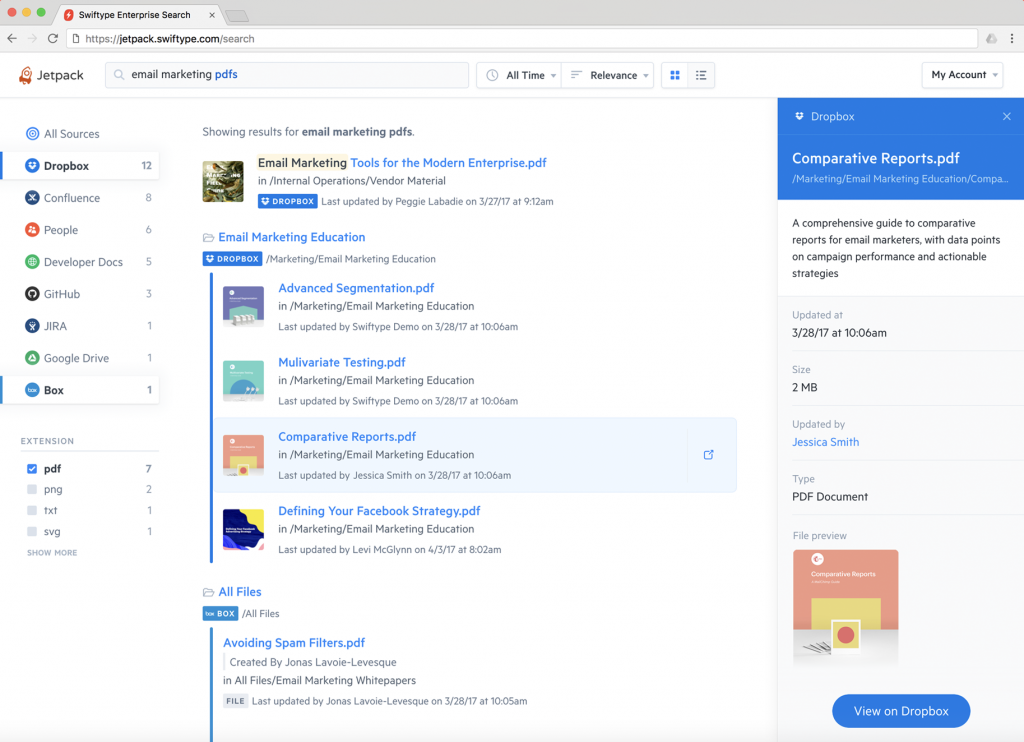I recently sat down with Quin Hoxie, CTO of Swiftype, to get a better understanding of Swiftype’s decision to move into the Enterprise Search space. Swiftype has historically been an industry-leading Site Search provider for businesses. In February of 2017, Swiftype announced its expansion into Enterprise Search, an application that allows employees to search across internal data sources.

SC: You used to focus primarily on Site Search. What made you shift into Enterprise Search?
QH: I think it’s only natural when you have a search platform as flexible and powerful as ours. We started to see some of our customers using the Site Search product in an Enterprise Search context. They were specifically using Site Search so that internal departments, like Support and Customer Success could search across their company’s intranet to better service customers. We also saw an explosion of cloud apps in the market but realized quickly that as companies were adopting these apps, they were jumping from app to app to find what they were looking for. The reality is that information is harder to find inside the workplace now than it was 10 years ago.
Legacy Enterprise search products also haven’t evolved much, both from a technological standpoint and a user experience standpoint. Matt and I were able to shed that baggage and figure out what enterprise search would look like if we designed it for the modern team. It became an interesting challenge, and after vetting the market we decided it was the right place for us to go.
SC: How is Swiftype different than other Enterprise Search platforms out there?
QH: The first difference is the time to implement Swiftype is really fast. From the start, we designed Swiftype Enterprise Search to address the new problem with internal search, not the old one. We’re a cloud provider, and we focus on companies who also work in the cloud. We’ve made it extremely easy for companies to connect to their cloud applications without having to involve heavy development resources. Some companies do still use a mixture of cloud and on-prem and that has been addressed with our product as well. Unfortunately, we’ve found that the technology in this space has lagged behind, and most enterprise search tech is still sitting on-premise, is expensive, labor-intensive, and more importantly their use of AI technologies hasn’t existed.
Second, permissioning is incredibly important when it comes to designing a platform for the modern team. Not all of your employees have access to the same data, even if they do use the same applications. Google Drive, for example, only gives you access to documents you’ve created or that have been shared with you. So what we do is take the permissions native to these applications and only show you what content is available to you. This to me is a deal breaker when companies are evaluating an enterprise search solution. A considerable amount of time and resources went into perfecting how we connect to other cloud apps.
We define sources into two different categories: Shared Sources and Individual Sources.
- Shared Sources are company-wide or team-wide data sources. This is when permissioning is not done on an individual by individual basis. Administrators can setup shared sources for the entire company or specific departments.
- Individual Sources: This is essentially the permissioning example I described earlier. Our employees at Swiftype connect to Google Drive, Evernote, Gmail, and Dropbox as individual sources so they only see content they have permission to see.
The beauty of connecting to sources in this way is that each employee gets a very personalized view of their search results. We also utilize AI to learn search and connector behaviors over time to improve their search experience. There are so many other differences. I think we’ll need a part 2.
SC: Speaking of AI Technologies, what’s different about Swiftype’s AI?
QH: The value of our AI is also a major differentiator in the marketplace. We’re able to track thousands of signals from the data that we ingest that enable us to be smarter about the results we deliver. As people connect their company data to Swiftype Enterprise Search, we’re collecting structured and unstructured content from many different sources. You have unstructured data, like text files in Dropbox, and structured data, like accounts, contacts and leads in Salesforce, and what we’re doing is taking what we know about all these different sources and using them to make the system smarter.
We call this the Enterprise Knowledge Graph, which is basically what we learn from all the interactions across the entire set of data, and distilling it down into what the actual relationships are across all the data in the company. The different systems all provide different levels of detail, for example if you look at a file that is a signed Non-disclosure Agreement in Dropbox, it doesn’t tell you which company it’s associated with, just who uploaded it, when it was last changed, and a mass of text. Using information from other connected sources, we’re able to figure out which company the file is associated with, who signed the document, and many other key details for that document.
SC: How long does the Enterprise Knowledge Graph in particular take to learn all these associations to present them in a way that’s meaningful?
QH: The short answer is: it starts immediately and continues to learn, but it comes with a lot of contextual knowledge out of the box.
The long answer is that we train the system with multi-level relevance models. The first layer is specific to users – based on a user’s specific activity and searching patterns, we know how to better serve results from one page to the next, or one query to the next.
The second layer is specific to an organization. We’ve found that throughout an organization, there are common workflows that a number of users perform. Swiftype Enterprise Search is able to detect these behavioral patterns and proactively apply optimizations. So if a user joins an organization in Swiftype, her system would already be optimized based on the usage of her colleagues.
The third layer is extremely important when it comes to cloud-based tools such as ours, and is more generalized to how systems learn from each other. We can enrich a PDF in Dropbox with what we know from Salesforce or Zendesk data to tie them all together and learn what the relationship between the systems are. This generalized layer is extremely beneficial because the moment you sign up and connect your data to Swiftype Enterprise Search, you can instantly benefit from that knowledge.
Because we’re a cloud-based provider, we’re able to layer these models on top of each other to create the best possible search experience. If you’re stuck on a server, you aren’t going to be able to draw on the collective knowledge of running Enterprise Search for thousands of companies. If your search algorithm is in complete isolation in a box in someone’s data center, there’s no communication between systems, no channel to say you’ve learned something new that you can apply to everyone.
When you’re talking about something like AI, it’s constantly evolving, not in batches or software updates, but every time a new piece of content comes in, every time someone clicks a result, and every time someone conducts a new search. It’s in real time.
SC: Thanks for breaking this all down, Quin. We’ve been hearing a lot about AI-Powered technologies lately, so it’s great to better understand the data science and behavioral analysis at the core of Swiftype’s search platform. With all the details and nuances behind Swiftype’s differentiators, it sounds like there is so much more that we could expand on. Let’s plan to chat again soon so we can dig even deeper into the landscape of Enterprise Search.
Can’t wait for part two? Want more info right now? Request a demo with our amazing sales team and they’ll walk you through it!










